Microstructural Evidence for Grain Boundary Migration and Dynamic Recrystallization in Experimentally Deformed Forsterite Aggregates
Abstract
1. Introduction
2. Materials and Methods
2.1. Synthesis
2.1.1. Sample M642
2.1.2. Sample For70B
2.2. Deformation Experiments
2.2.1. Sample M642
2.2.2. Sample 70B
2.3. Orientation Mapping in the Transmission Electron Microscope
- The kernel average misorientation (KAM) calculates the average misorientation between a pixel and its neighbors, provided that the misorientation does not exceed a predefined threshold value (e.g., 5°, which is the value chosen here for all figures). Hence, the incorporation of well-defined GB is avoided. A kernel is a set of points of prescribed size surrounding the scan point of interest. The size of the kernel is generally prescribed to the nth nearest neighbors. Hence, this parameter is sensitive to the step size of the measurement grid. If plastic deformation results from dislocation glide and crystal lattice rotation, this approach allows quantitative evaluation of the local plastic strain gradients [29]. KAM is consequently used as a proxy of the local plastic strain.
- The grain orientation spread (GOS) is the average deviation in orientation between each point in a grain and the average orientation of the grain. This approach leads to assigning the same value of the GOS to every scan point contained within a grain.
- The grain reference orientation deviation (GROD) is based on the misorientation between a reference point of that grain and the other points. The reference point can be the mean misorientation of the grain (in this case and in MTEX, the GROD is called the Mis2Mean, as referred in this paper) or the point of the grain where the KAM is the lowest.
3. Results
4. Discussion
5. Conclusions
Author Contributions
Acknowledgments
Conflicts of Interest
References
- Von Mises, R.V. Mechanik der plastischen Formänderung von Kristallen. Z. Angew. Math. Mech. 1928, 8, 161–185. [Google Scholar] [CrossRef]
- Taylor, G.I. Plastic strain in metals. J. Inst. Met. 1938, 62, 307–324. [Google Scholar]
- Demouchy, S.; Mussi, A.; Barou, F.; Tommasi, A.; Cordier, P. Viscoplasticity of polycrystalline olivine experimentally deformed at high pressure and 900 °C. Tectonophysics 2014, 623, 123–135. [Google Scholar] [CrossRef]
- Drury, M.R.; Urai, J.L. Deformation-related recrystallization processes. Tectonophysics 1990, 3–4, 235–253. [Google Scholar] [CrossRef]
- Wenk, H.R.; Tomé, C.N. Modeling dynamic recrystallization of olivine aggregates deformed in simple shear. J. Geophys. Res. 1999, 104, 25513–25527. [Google Scholar] [CrossRef]
- Lee, K.-H.; Jiang, Z.; Karato, S.-I. A scanning electron microscope study of the effects of dynamic recrystallization on lattice preferred orientation in olivine. Tectonophysics 2002, 351, 331–341. [Google Scholar] [CrossRef]
- Falus, G.; Tommasi, A.; Soustelle, V. The effect of dynamic recrystallization on olivine crystal preferred orientations in mantle xenoliths deformed under varied stress conditions. J. Struct. Geol. 2011, 33, 1528–1540. [Google Scholar] [CrossRef]
- Boneh, Y.; Wallis, D.; Hansen, L.N.; Krawczynski, M.J.; Skemer, P. Oriented grain growth and modification of ‘frozen anisotropy’ in the lithospheric mantle. Earth Planet. Sci. Lett. 2017, 474, 368–374. [Google Scholar] [CrossRef]
- Austin, N.J.; Evans, B. Paleowattmeters: A scaling relation for dynamically recrystallized grain size. Geology 2007, 35, 343–346. [Google Scholar] [CrossRef]
- Ricard, Y.; Bercovici, D. A continuum theory of grain size evolution and damage. J. Geophys. Res. 2009, 114, B01204. [Google Scholar] [CrossRef]
- Rozel, A.; Ricard, Y.; Bercovici, D. A thermodynamically self-consistent damage equation for grain size evolution during dynamic recrystallization. Geophys. J. Int. 2011, 184, 719–728. [Google Scholar] [CrossRef]
- Trepmann, C.A.; Renner, J.; Druiventak, A. Experimental deformation and recrystallization of olivine–processes and timescales of damage healing during postseismic relaxation at mantle depths. Solid Earth 2013, 4, 423–450. [Google Scholar] [CrossRef]
- Karato, S.; Toriumi, M.; Fuji, T. Dynamic recrystallization of olivine single crystals during high-temperature creep. Geophys. Res. Lett. 1980, 7, 649–652. [Google Scholar] [CrossRef]
- Humphreys, F.J.; Hatherly, M. Recrystallization and Related Annealing Phenomena, 2nd ed.; Elsevier: Oxford, UK, 2004; pp. xxi–xxii. ISBN 9780080441641. [Google Scholar]
- Sakai, T.; Belyakov, A.; Kaibyshev, R.; Miura, H.; Jonas, J.J. Dynamic and post-dynamic recrystallization under hot, cold and severe plastic deformation conditions. Prog. Mater. Sci. 2014, 60, 130–207. [Google Scholar] [CrossRef]
- Bollinger, C.; Raterron, P.; Cordier, P.; Merkel, S. Polycrystalline olivine rheology in dislocation creep: Revisiting experimental data to 8.1 GPa. Phys. Earth Planet. Inter. 2014, 228, 211–219. [Google Scholar] [CrossRef]
- Bollinger, C.; Merkel, S.; Cordier, P.; Raterron, P. Deformation of forsterite polycrystals at mantle pressure: Comparison with Fe-bearing olivine and the effect of iron on its plasticity. Phys. Earth Planet. Inter. 2015, 240, 95–104. [Google Scholar] [CrossRef]
- Bollinger, C.; Marquardt, K.; Ferreira, F. Intragranular plasticity vs. grain boundary sliding (GBS) in forsterite: Microstructural evidence at high pressures (3.5–5.0 GPa). Am. Min. 2018. [Google Scholar] [CrossRef]
- Guignard, J.; Bystricky, M.; Béjina, F. Dense fine-grained aggregates prepared by spark plasma sintering (SPS), an original technique in experimental petrology. Eur. J. Mineral. 2011, 23, 323–331. [Google Scholar] [CrossRef]
- Manthilake, M.A.G.M.; Walter, N.; Frost, D.J. A new multi-anvil press employing six independently acting 8 MN hydraulic rams. High. Press. Res. 2012, 32, 195–207. [Google Scholar] [CrossRef]
- Durham, W.B.; Weidner, D.J.; Karato, S.I.; Wang, Y. New developments in deformation experiments at high pressure. Rev. Mineral. Geochem. 2002, 51, 21–49. [Google Scholar] [CrossRef]
- Wang, Y.; Durham, W.B.; Getting, I.C.; Weidner, D.J. The deformation-DIA: A new apparatus for high temperature triaxial deformation to pressures up to 15 GPa. Rev. Sci. Instrum. 2003, 74, 3002–3011. [Google Scholar] [CrossRef]
- Rauch, E.F.; Véron, M. Automated crystal orientation and phase mapping in TEM. Mater. Charact. 2014, 98, 1–9. [Google Scholar] [CrossRef]
- Birle, J.D.; Gibbs, G.V.; Moore, P.B.; Smith, J.V. Crystal structures of natural olivines. Am. Mineral. 1968, 53, 807–824. [Google Scholar]
- Rauch, E.F.; Dupuy, L. Rapid diffraction patterns identification through template matching. Arch. Metall. Mater. 2005, 50, 87–99. [Google Scholar]
- Hielscher, R.; Schaeben, H. A novel pole figure inversion method: Specification of the MTEX algorithm. J. Appl. Cryst. 2008, 41, 1024–1037. [Google Scholar] [CrossRef]
- Bachmann, F.; Hielscher, R.; Schaeben, H. Grain detection from 2d and 3d EBSD data–Specification of the MTEX algorithm. Ultramicroscopy 2011, 111, 1720–1733. [Google Scholar] [CrossRef] [PubMed]
- Wright, S.I.; Nowell, M.M.; Field, D.P. A review of strain analysis using electron backscatter diffraction. Microsc. Microanal. 2011, 17, 316–329. [Google Scholar] [CrossRef]
- Godfrey, A.; Cao, W.Q.; Hansen, N.; Liu, Q. Stored energy, microstructure, and flow stress of deformed metals. Metall. Mater. Trans. A 2005, 36, 2371–2378. [Google Scholar] [CrossRef]
- Nzogang, B.C.; Bouquerel, J.; Cordier, P.; Mussi, A.; Girard, J.; Karato, S. Characterization by scanning precession electron diffraction of an aggregate of bridgmanite and ferropericlase deformed at HP-HT. Geochem. Geophys. Geosyst. 2018, 19, 582–594. [Google Scholar] [CrossRef]
- Nzogang, B.C.; Thilliez, S.; Mussi, A.; Kawazoe, T.; Miyajima, N.; Bouquerel, J.; Cordier, P. Application of Scanning Precession Electron Diffraction in the Transmission Electron Microscope to the Characterization of Deformation in Wadsleyite and Ringwoodite. Minerals 2018, 8, 153. [Google Scholar] [CrossRef]
- Ham, R.K. The determination of dislocation densities in thin films. Philos. Mag. 1961, 6, 1183–1184. [Google Scholar] [CrossRef]
- Signorelli, J.; Tommasi, A. Modeling the effect of subgrain rotation recrystallization on the evolution of olivine crystal preferred orientations in simple shear. Earth Planet. Sci. Lett. 2015, 430, 356–366. [Google Scholar] [CrossRef]
- Toriumi, M. Grain boundary migration in olivine at atmospheric pressure. Phys. Earth Planet. Inter. 1982, 30, 26–35. [Google Scholar] [CrossRef]
- Cooper, R.F.; Kohlstedt, D.L. Sintering of olivine and olivine-basalt aggregates. Phys. Chem. Miner. 1984, 11, 5–16. [Google Scholar] [CrossRef]
- Takahashi, M.; Nagahama, H.; Masuda, T.; Fujimura, A. Fractal analysis of experimentally, dynamically recrystallized quartz grains and its possible application as a strain rate meter. J. Struct. Geol. 1998, 20, 269–275. [Google Scholar] [CrossRef]
- Vauchez, A.; Dineur, F.; Rudnick, R. Microstructure, texture and seismic anisotropy of the lithospheric mantle above a mantle plume: Insights from the Labait volcano xenoliths (Tanzania). Earth Planet. Sci. Lett. 2005, 232, 295–314. [Google Scholar] [CrossRef]
- Tommasi, M.; Godard, M.; Coromina, G.; Dautria, J.M.; Barsczus, H. Seismic anisotropy and compositionally induced velocity anomalies in the lithosphere above mantle plumes: A petrological and microstructural study of mantle xenoliths from French Polynesia. Earth Planet. Sci. Lett. 2004, 227, 539–556. [Google Scholar] [CrossRef]
- Tommasi, A.; Baptiste, V.; Vauchez, A.; Holtzman, B. Deformation, annealing, reactive melt percolation, and seismic anisotropy in the lithospheric mantle beneath the southeastern Ethiopian rift: Constraints from mantle xenoliths from Mega. Tectonophysics 2016, 682, 186–205. [Google Scholar] [CrossRef]
- Gottstein, G.; Shvindlerman, L.S. Grain Boundary Migration in Metals, 2nd ed.; CRC Press, Taylor and Francis group: Boca Raton, FL, USA, 2010; p. 674. ISBN 978-1-4200-5436-1. [Google Scholar]
- Mullins, W.W. Two-dimensional motion of idealized grain boundaries. J. Appl. Phys. 1956, 27, 900–904. [Google Scholar] [CrossRef]
- Duyster, J.; Stöckhert, B. Grain boundaries energies in olivine derived from natural microstructures. Contrib. Mineral. Petrol. 2001, 140, 567–576. [Google Scholar] [CrossRef]
- Miura, H.; Sakai, T.; Mogawa, R.; Jonas, J.J. Nucleation of dynamic recrystallization and variant selection in copper bicrystals. Philos. Mag. 2007, 87, 4197–4209. [Google Scholar] [CrossRef]
- Chauve, T.; Montagnat, M.; Barou, F.; Hidas, K.; Tommasi, A.; Mainprice, D. Investigation of nucleation processes during dynamic recrystallization of ice using cryo-EBSD. Philos. Trans. R. Soc. A 2017, 375. [Google Scholar] [CrossRef] [PubMed]
- Maruyama, G.; Hiraga, T. Grain- to multiple-grain-scale deformation processes during diffusion creep of forsterite + diopside aggregate: 1. Direct observations. J. Geophys. Res. 2017, 122, 5890–5915. [Google Scholar] [CrossRef]
- Maruyama, G.; Hiraga, T. Grain- to multiple-grain-scale deformation processes during diffusion creep of forsterite + diopside aggregate: 2. Grain boundary sliding-induced grain rotation and its role in crystallographic preferred orientation in rocks. J. Geophys. Res. 2017, 122, 5916–5934. [Google Scholar] [CrossRef]
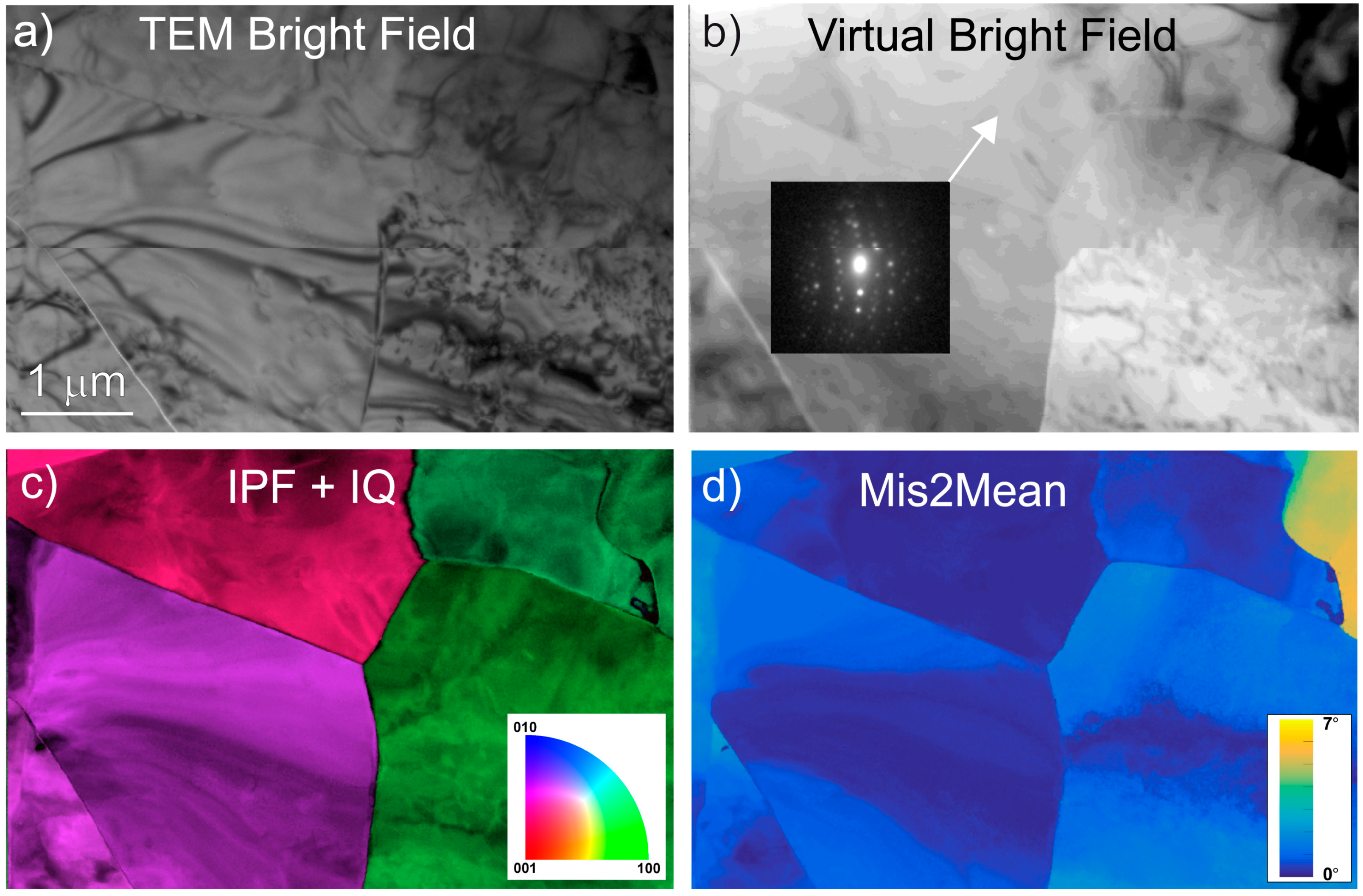
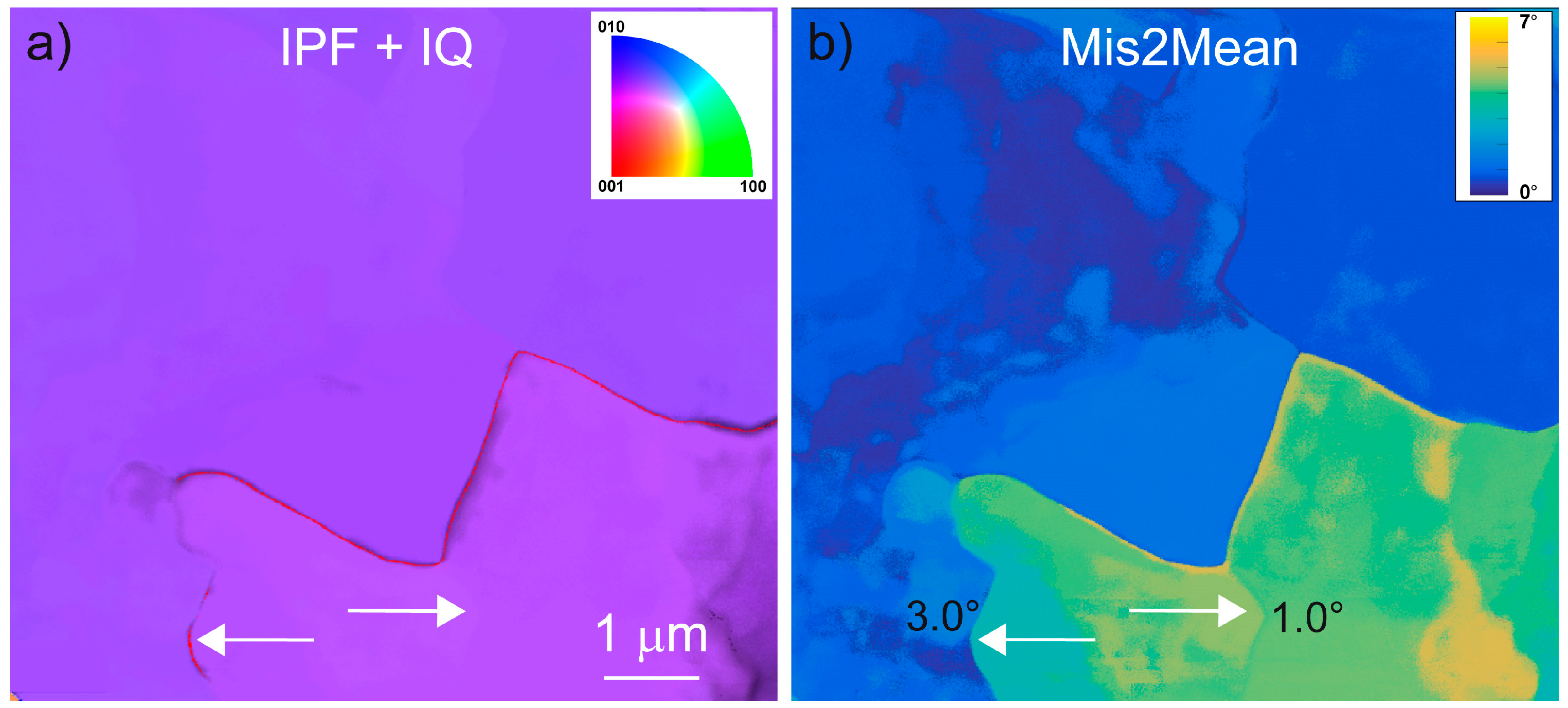
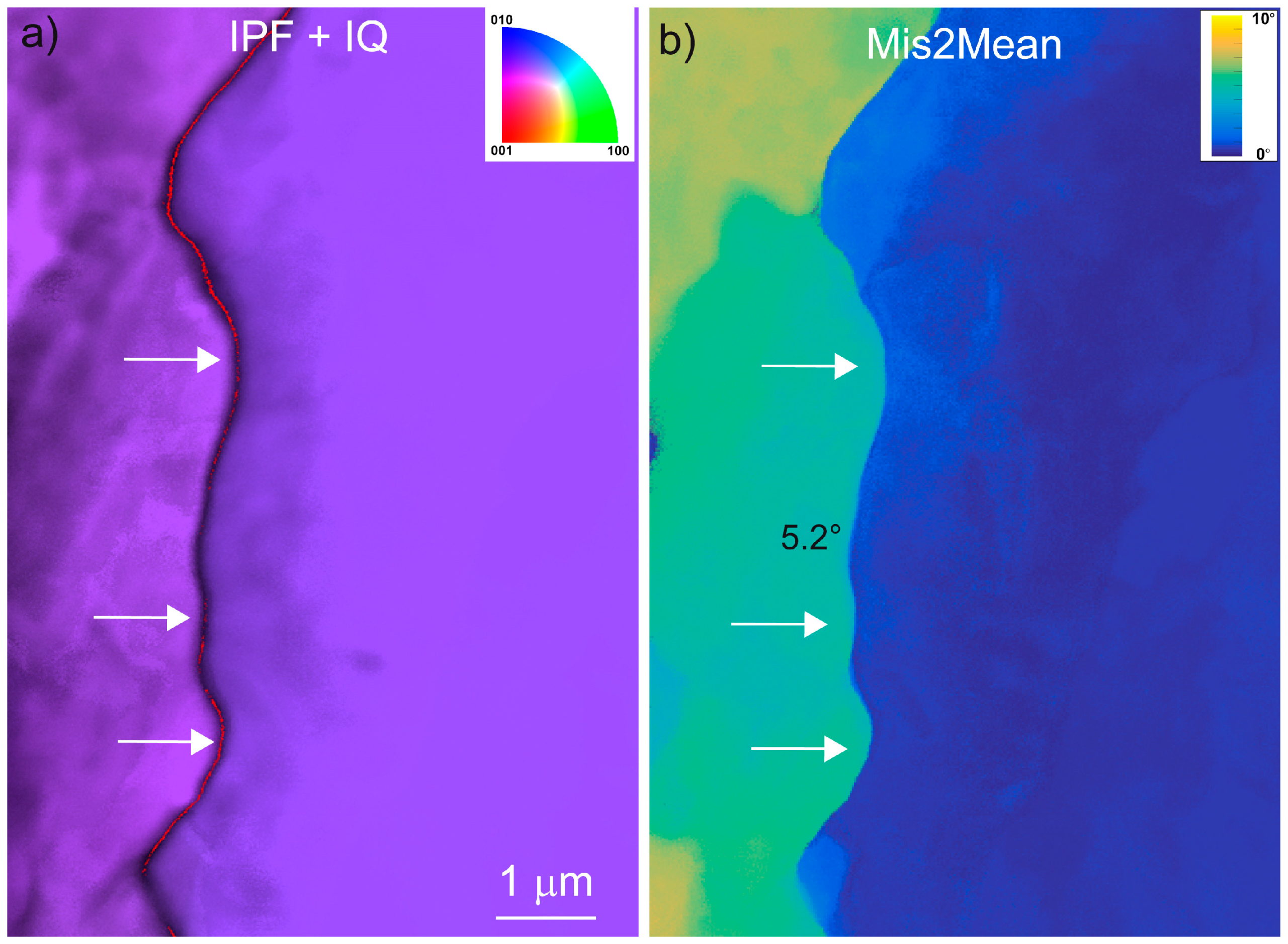

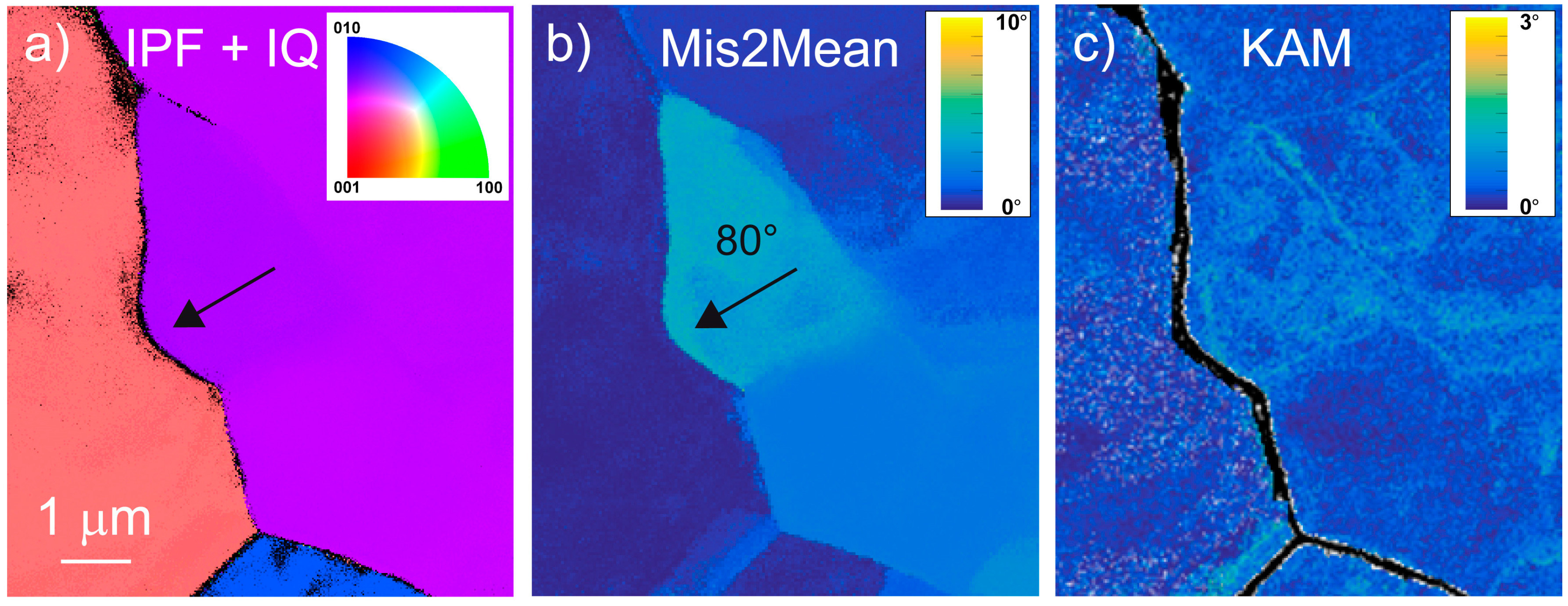
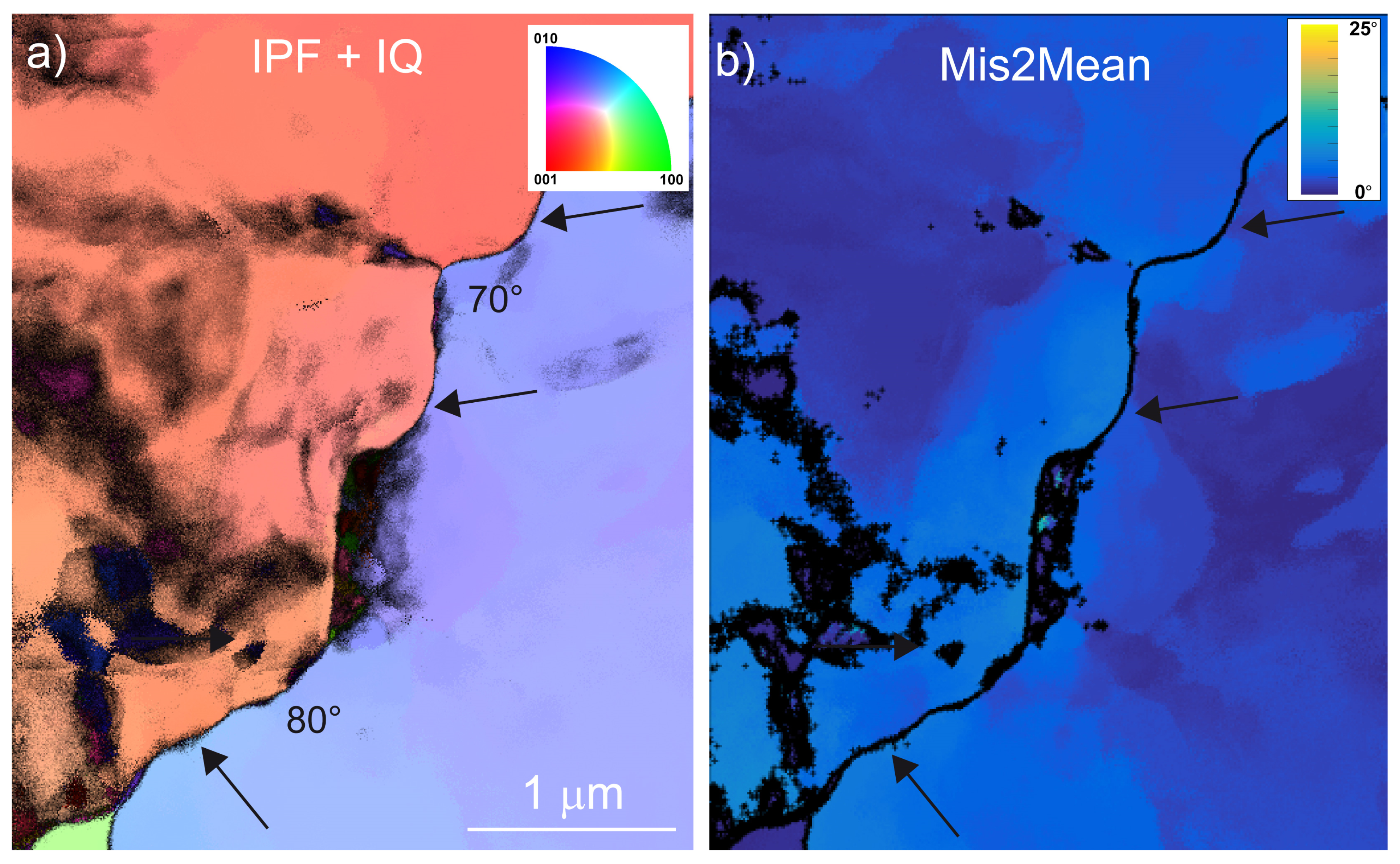
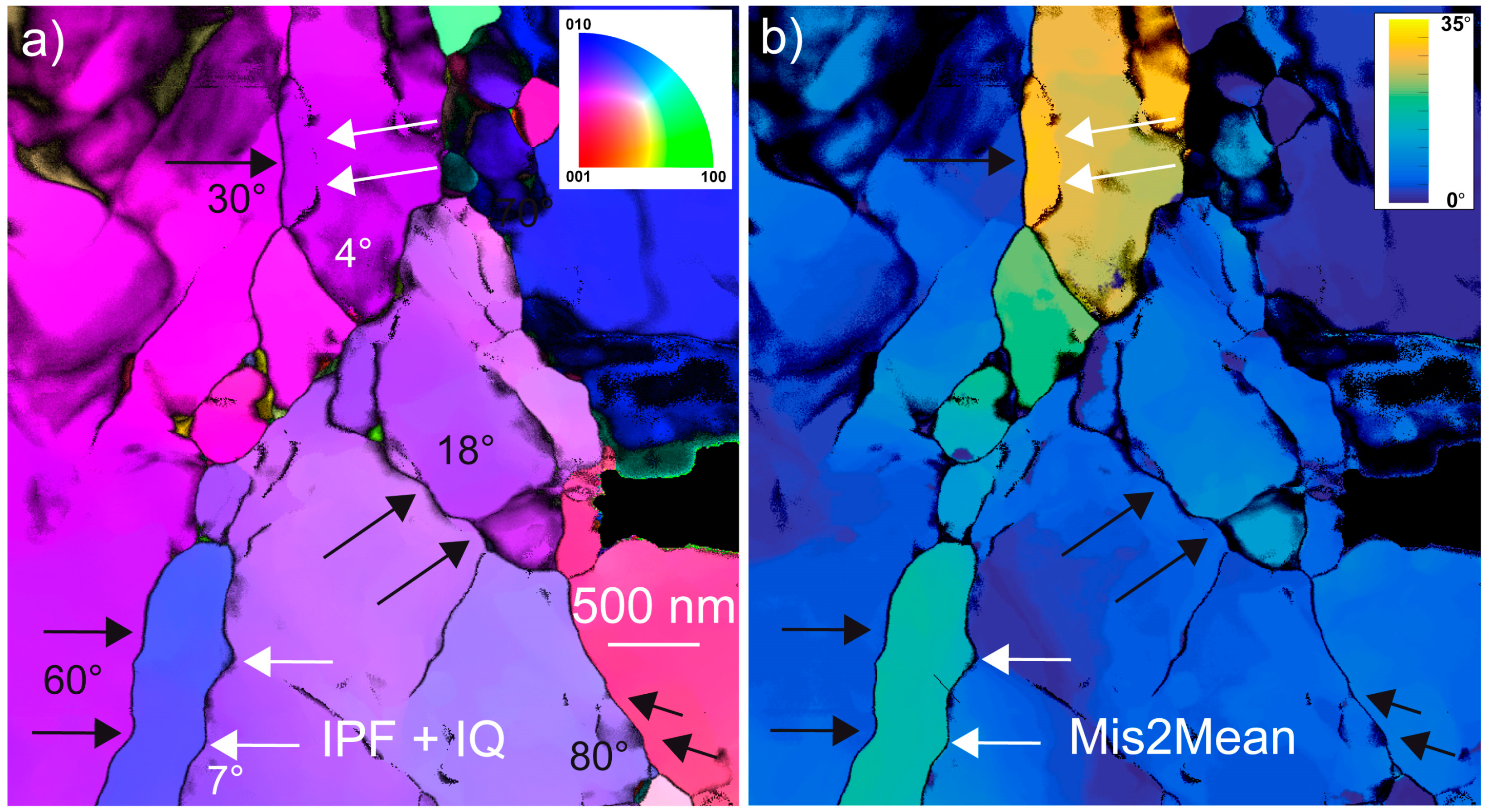

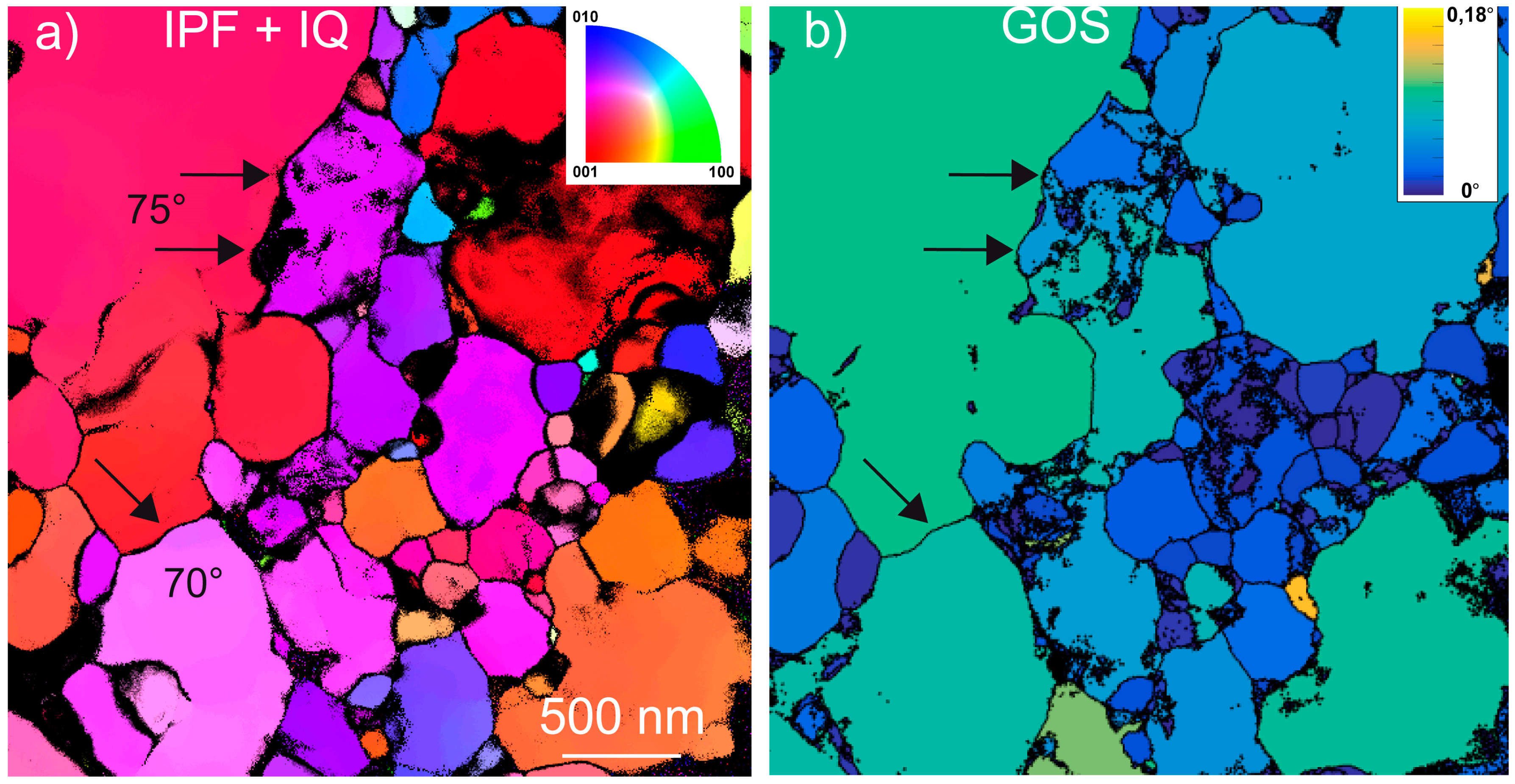
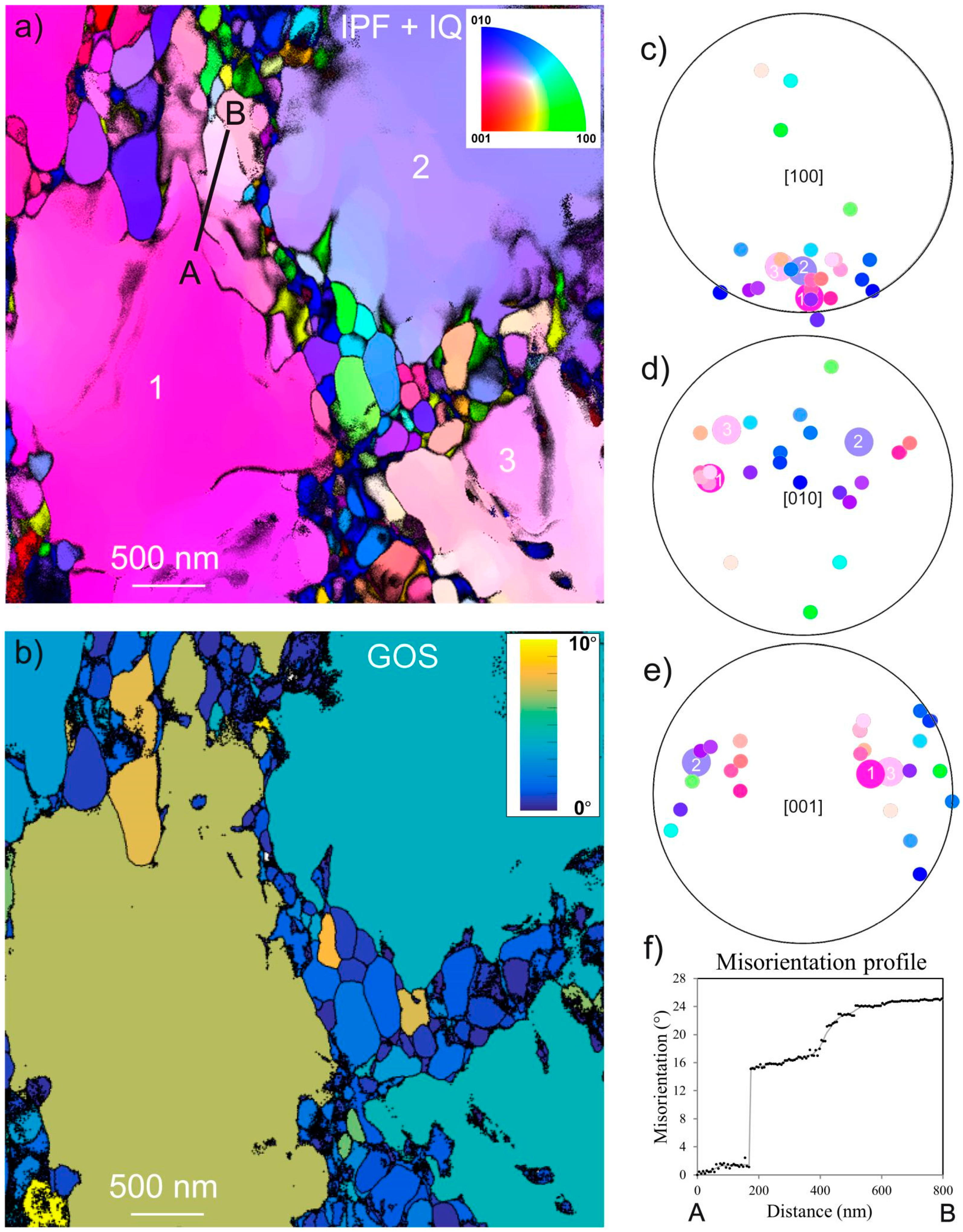
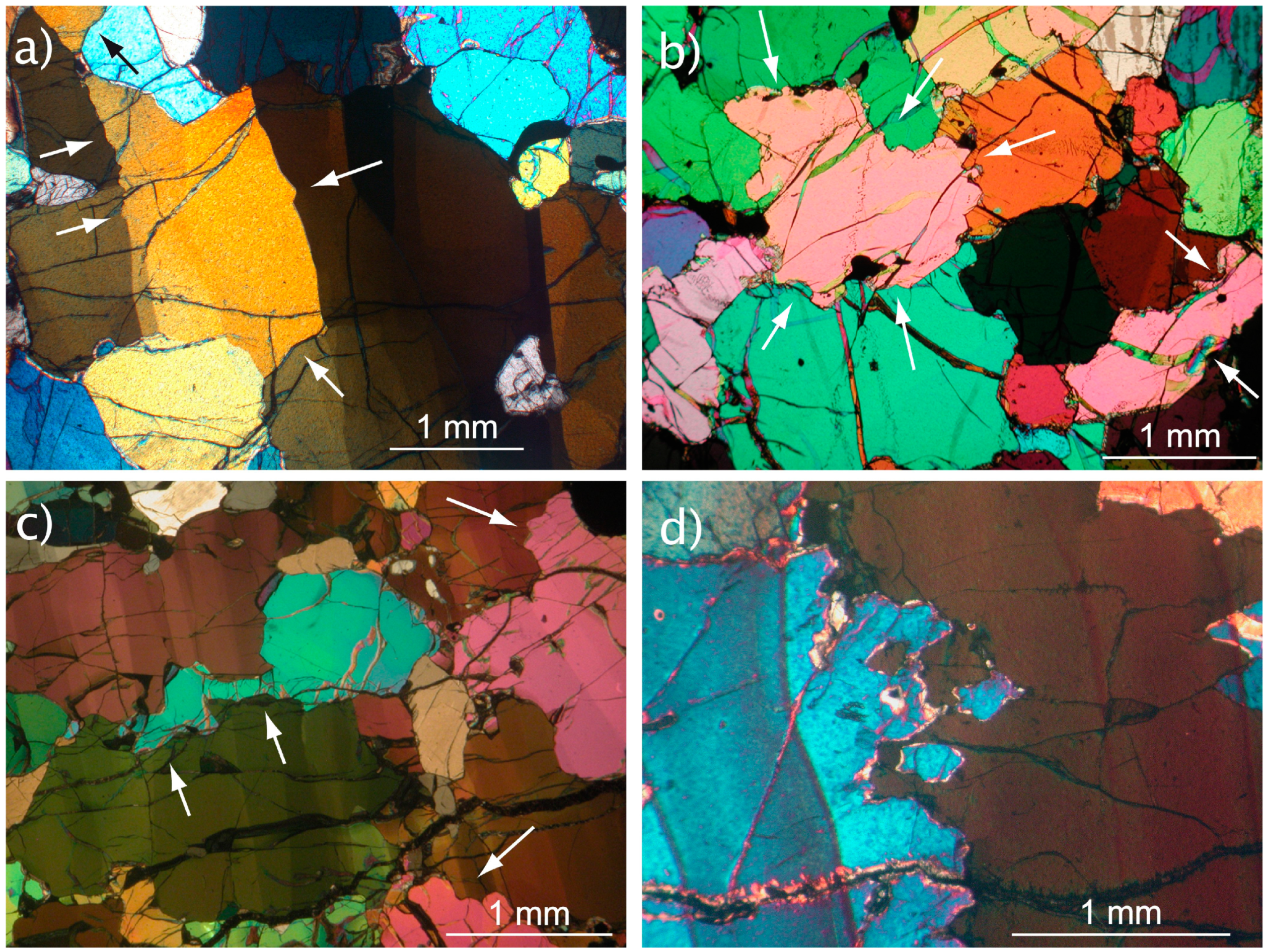
| Run # | T (°C) | P (GPa) | (10−5 s−1) | ε (%) | Average Grain Size (µm) | Def. | Deformation Press | Reference Paper |
|---|---|---|---|---|---|---|---|---|
| M642 | 1100 | 3.5 | 5.0 | ~25 | 20–100 | Pure shear | 6-ram MAVO press, BGI, Bayreuth, Germany | [18] |
| For70B | 1100 | 3.1 | 4.5 | 40 | 0.2–3.0 | Uniaxial | D-DIA, NSLS, NY, USA | [17] |
© 2018 by the authors. Licensee MDPI, Basel, Switzerland. This article is an open access article distributed under the terms and conditions of the Creative Commons Attribution (CC BY) license (http://creativecommons.org/licenses/by/4.0/).
Share and Cite
Bollinger, C.; Nzogang, B.C.; Mussi, A.; Bouquerel, J.; Molodov, D.A.; Cordier, P. Microstructural Evidence for Grain Boundary Migration and Dynamic Recrystallization in Experimentally Deformed Forsterite Aggregates. Minerals 2019, 9, 17. https://doi.org/10.3390/min9010017
Bollinger C, Nzogang BC, Mussi A, Bouquerel J, Molodov DA, Cordier P. Microstructural Evidence for Grain Boundary Migration and Dynamic Recrystallization in Experimentally Deformed Forsterite Aggregates. Minerals. 2019; 9(1):17. https://doi.org/10.3390/min9010017
Chicago/Turabian StyleBollinger, Caroline, Billy C. Nzogang, Alexandre Mussi, Jérémie Bouquerel, Dmitri A. Molodov, and Patrick Cordier. 2019. "Microstructural Evidence for Grain Boundary Migration and Dynamic Recrystallization in Experimentally Deformed Forsterite Aggregates" Minerals 9, no. 1: 17. https://doi.org/10.3390/min9010017
APA StyleBollinger, C., Nzogang, B. C., Mussi, A., Bouquerel, J., Molodov, D. A., & Cordier, P. (2019). Microstructural Evidence for Grain Boundary Migration and Dynamic Recrystallization in Experimentally Deformed Forsterite Aggregates. Minerals, 9(1), 17. https://doi.org/10.3390/min9010017






